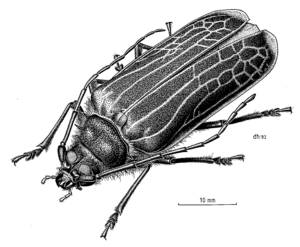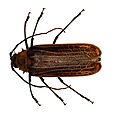Huhu beetle facts for kids
Quick facts for kids Huhu beetle |
|
|---|---|
 |
|
| Prionoplus reticularis illustration by Des Helmore | |
| Scientific classification |
The huhu beetle (Prionoplus reticularis) is a type of longhorn beetle that lives only in New Zealand. It is the heaviest beetle you can find there!
Contents
Māori Names for the Huhu Beetle
The Māori people have special names for the huhu beetle at different stages of its life. The young, worm-like stage (the larva) is called huhu, tunga haere, or tunga rākau. The fully grown adult beetle is known as pepe-te-muimui.
When the huhu larva is almost ready to change, it stops eating wood and sheds its skin. At this point, it's called tataka and is still edible. Then, it starts to grow wings and legs. While it's still white, it's known as pepe. Finally, it comes out of the wood and flies away to have babies, and it's called tunga rere.
Huhu Beetle Life Cycle
Eggs and Hatching
Female adult huhu beetles lay their eggs in groups of 10 to 50, though sometimes up to 100 eggs can be found together. These eggs are about 3mm long and shaped like cigars. They are usually laid in hidden spots or in cracks in the bark of fallen wood. In warm lab conditions, these eggs hatch in about 23 days.
Before hatching, the tiny larva can be seen moving inside the egg. It uses its strong mouthparts to break out. The larva doesn't eat the eggshell. Small hairs on its body help it move out of the egg and start digging its first tunnel in the wood.
The Larval Stage
The huhu larvae are whitish and can grow up to 70 millimetres (2.8 in) long. They mostly eat dead wood from conifer trees, especially those found in New Zealand's lowland forests. In the wild, the larval stage of the huhu beetle lasts for two to three years. However, in a lab with a special diet and warm temperatures, this stage can be as short as 250 days.
When a larva is ready to change into a pupa, it moves close to the surface of the wood, about 7.5 to 10cm deep. It then builds a special room called a pupal chamber. This takes one to three days. The larva makes wood shavings and packs them into its tunnel to block it off. After that, it lines the walls of its new room with its last waste. The larva then rests for about 10 to 15 days, its body changes slightly, and then it sheds its skin to become a pupa.
From Pupa to Adult Beetle
The pupa stage lasts about 25 days. During this time, the beetle finishes developing its body parts. When the adult beetle is ready to come out, it breaks open its pupal skin. The head, legs, and wings are freed as the beetle arches its body. The newly emerged adult beetle might stay inactive for three to five days before it digs its way out of the wood.
Once the adult beetle comes out, it doesn't eat anything. It lives for about two weeks, mainly to find a mate and reproduce.
Huhu Beetle Behavior
Huhu beetles are active at night. They are often drawn to lights from houses. In 1892, someone named Hudson noted that they "frequently leads it on summer evenings to invade ladies' drawing-rooms, when its sudden and noisy arrival is apt to cause much needless consternation amongst the inmates." This means they can fly into homes and cause a bit of a stir!
These beetles have very strong mandibles (jaws). If they bite you, it can be quite painful.
Female huhu beetles release a special smell that attracts male huhu beetles. If a huhu beetle feels bothered, it will put on a show. It might push its head forward, open its mandibles wide, wave its antennae, and move its head up and down. If two beetles have an intense face-off, they might even fight. They grapple with their front legs, often resulting in one beetle being flipped onto its back. If anything touches their mandibles, they grab it, sometimes causing them to lose a leg or other body part.
Huhu Grubs as Food
The larvae (grubs) of the huhu beetle can be eaten by humans. People have been eating them for a very long time, especially the Māori people. Some say they taste like buttery chicken or peanut butter!
As mentioned before, there are different Māori names for the grubs depending on their stage. Young grubs still eating wood are called tunga haere or tunga rākau. The full-grown grubs that have stopped eating and are ready to change are called tataka. These are the most popular to eat because they don't have any undigested wood inside them. Huhu grubs can be eaten raw or cooked, often in a traditional hāngi (earth oven). They are a great source of fat, especially in the New Zealand wilderness.
Images for kids









